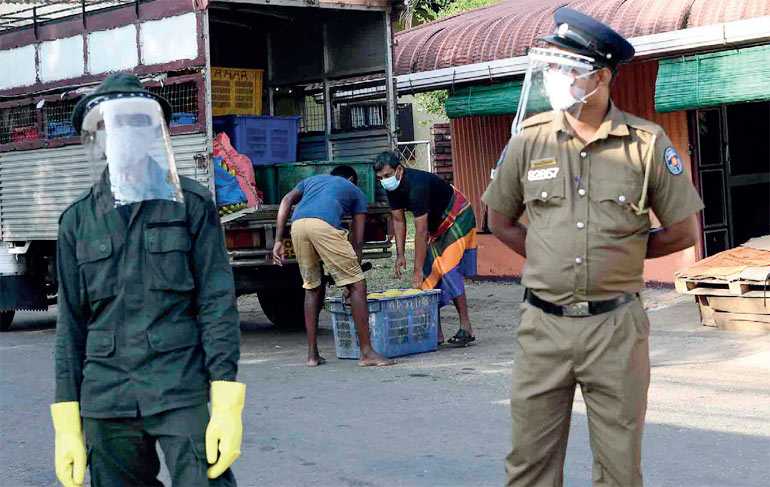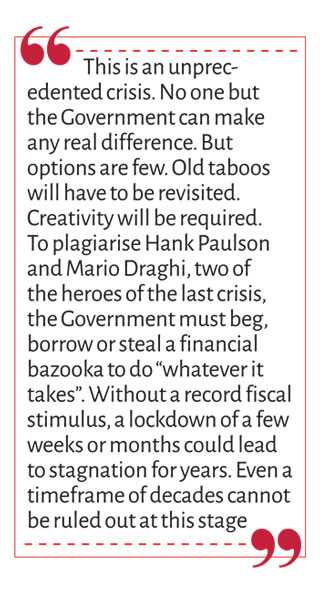Wednesday Apr 09, 2025
Wednesday Apr 09, 2025
Monday, 6 April 2020 00:00 - - {{hitsCtrl.values.hits}}

Most economic activity has come to a standstill. With social distancing measures in place, consumers are unable to consume. Investors are unable to invest. Exporters are unable to export. The tourism, aviation and apparel sectors have ceased almost all operations. This is just the beginning – Pic by Shehan Gunasekara
“This is a crisis like no other,” declared the Managing Director of the IMF, an institution not known for overstatement. When this alarm is followed by “never in the history of the IMF have we witnessed the world economy coming to a standstill” and “this is way worse than the Global Financial Crisis,” there is no doubt that a fearsome storm is upon us.
Even at this early stage, the coronavirus pandemic leaves an unprecedented economic shock in its wake. High-frequency indicators suggest globally synchronised supply and demand shocks, combined with a flight away from emerging markets and other risky asset classes. 
To make matters worse, there is no ‘Committee to Save the World’ a la the East Asian Crisis, or concerted G20 action, which held the global economy together during the Global Financial Crisis. The abdication of US leadership and Sino-US tensions, the primary causes for limited global coordination today, could not come at a worse time.
Sri Lankan economy
A quick survey of the real economy in Sri Lanka makes this apparent. As I write this article, most economic activity has come to a standstill. With social distancing measures in place, consumers are unable to consume. Investors are unable to invest. Exporters are unable to export. The tourism, aviation and apparel sectors have ceased almost all operations.
This is just the beginning. As the shock filters through the economy, even if actors are able to spend, they may not be willing. Animal spirits will be muted, savings for a rainy day will rise. Demand will fall significantly across the economy for a sustained period of time.
If consumers, businesses and the global market cannot generate demand, then the government must step in. This is the dearly purchased lesson of the Great Depression. If the Government fails to write large cheques and many of them; businesses will fold, banks will bust and mass unemployment will follow.
An increasingly large body of evidence – called the hysteresis literature – suggests that such large and prolonged recessions change the structural path of countries, through the destruction of skills and social cohesion. We cannot allow this to happen.
Tragically Sri Lanka’s public finances were already precarious prior to this crisis. The upshot is simple. If the Government writes the cheques needed to keep the economy afloat, many will bounce. The sources of this fragility are both old and new. Sri Lanka has historically maintained a high debt-to-GDP ratio. However, since 2007 Sri Lanka’s risk exposure increased considerably.
In addition to a high debt-to-GDP ratio, the Sri Lankan Government liberally borrowed short-maturity debt from international markets at high-interest rates. Until 2017, when the VAT rate rose, this borrowing spree was paired with an exceptionally low and falling tax-to-GDP ratio. The gains of 2017 to 2019 were reversed, and more, with the tax-cuts earlier this year.
This slow train to default accelerated with the constitutional coup in late 2018, the Easter bombings, the myopic tax-cuts and now the coronavirus pandemic. All in all, Sri Lanka’s public finances are in an exceptionally stressed state.
The recent depreciation of the rupee is exacerbating this situation. As the rupee falls, Sri Lanka’s debt-to-GDP ratio rises. This is because about half of Sri Lanka’s public debt is denominated in foreign currencies. Rising debt-to-GDP ratios further erode investor confidence and could lead to further pressure on the rupee (capital controls help for a time of course).
There is also the temptation to accelerate monetary financing of the deficit when Government revenues experience such a shock. In the last month alone, the Central Bank printed money to purchase Rs. 170 billion worth of Treasury bills. This too places pressure on the exchange rate.
Implementing the standard fire-fighting tool-kit
Implementing the standard fire-fighting tool-kit is a key first step. First, secure the best possible bail-out package from multilateral and bilateral creditors. Here too, goodwill is not at a high. The Government of Sri Lanka gave the IMF the proverbial finger early this year – making mockery of the fiscal deficit target and structural benchmarks, such as the Monetary Law Act. That relationship will have to be restored immediately.
Second, swap lines are playing an increasingly important role in crisis fighting too. The Central Bank and Foreign Ministry should be working hard to expand existing foreign currency swap lines, such as those with the People’s Bank of China and Reserve Bank of India. In addition to opening new ones, such as with the Bank of Japan.
Third, the $500 million grant from the Millennium Challenge Corporation is vital. There can be do delay. Parliament must also be convened to place revenue and borrowing measures on a legal footing. This will help restore some small measure of donor and investor confidence.
It will also resolve the problem where between 30 April – the end of the Vote on Account – and 14 May (on some readings the date of the activation of Section 150(3)), it is unclear whether any person or agent in the Government has the authority to spend funds or raise debt.
However even a generous bail-out package, deft Central Bank action, access to grants and restoring the legal footing underpinning public finance will not be sufficient. With a collapse in both demand and supply, the Government must provide a record stimulus. To avert an unprecedented depression, the Government must spend lavishly and swiftly. But the Government cannot spend. It does not have the fiscal space to do so.
Markets expect a default before October. Yields on Government debt are reaching the triple digits on secondary markets, up from the mid-single digits even in the aftermath of the Easter bombings. The recent $ 220 million issuance of Sri Lanka Development Bonds only attracted $22 million worth of bids. Therefore, the challenge is to find ways for the Government to borrow so that it can spend to replace consumer, business and export demand.
Generating financing for large fiscal stimulus amidst crisis
The following thoughts are speculative. The ideas are unorthodox. They have not been examined carefully. But these are not ordinary times. Following tried and tested methods will almost certainly fall short. Boldness, speed and creativity are called for.
In these circumstances, the perfect is the enemy of the good. Therefore, I share these ideas not with confidence but as a vehicle for generating a conversation on how a highly-indebted country like Sri Lanka can generate the financing for a large fiscal stimulus amidst an unprecedented crisis.
In normal times, asset sales would have been an obvious choice. The Government could sell the assets it has hopelessly mismanaged in order to finance a stimulus. But there are two problems with this approach. First, any asset sale will be at firesale prices. Second, it will take time to conduct such a sale. But there are less conventional instruments for raising capital fast.
Thus far all public debt issued by the Sri Lankan Government has been uncollateralised. That is no Treasury bill, Treasury bond, Sri Lanka Development Bond or International Sovereign Bond grants the holder a security interest in any asset.
However, many other countries, especially those with poor credit-ratings like Sri Lanka have issued collateralised bonds. They provide a way to access credit at lower interest rates because they are linked to a real asset. This may be one of very few avenues Sri Lanka can use to tap capital markets at this desperate time.
Cabinet has already approved the creation of a holding company for assets owned by the Government, such as the Hilton, Hyatt and Grand Oriental Hotels. Other Government owned assets can also be included in this holding company to create a diversified and substantive asset pool. This can also be complemented by shares the government owns in publicly-listed companies. For example, the Government owns significant stakes in SLT, NDB and DFCC. 
Backed by this holding company’s assets, a special purpose vehicle can issue a couple of billion dollars’ worth of bonds on international capital markets. It should be very clear that this bond does not have a Government guarantee. This helps ensure that any re-scheduling or conversion of the debt that may take place in the future does not affect the Government’s unblemished repayment record of over 70 years.
Concomitantly, even if the bonds are issued under US law (as is the case with Sri Lanka’s international sovereign bonds), investors will be concerned about their ability to enforce their security interest in the event of default. The Government can offer comfort on this anxiety too. Considering the desperate need for these funds, it would be constitutionally proper for the President to seek the opinion of the Supreme Court on the enforceability of that interest.
In terms of cash-flow confidence, the Government could make selection of holding company directors a responsibility of the Constitutional Council. Such an apolitical and transparent process will help appoint professional management. Thus creating investor confidence in cashflows needed to repay the debt.
The funds raised by this bond can be used for infrastructure projects that generate an economic stimulus. For example, they can be used to fund projects in public transportation, energy, industrial parks and airports. Ideally the projects will be PPPs, as they enable further mobilisation of capital and thus stimulus. While the projects are being prepared to become shovel-ready, the SPV can lend the money to the Treasury or state-banks to generate an immediate economic stimulus.
Even should the holding company default on debt in a couple of years, the liquidation of assets will take place after the peak of the crisis passes. Therefore, asset prices are likely to be more reflective of their value in tranquil times. Moreover, the liquidation will be managed transparently – perhaps via a stock exchange listing – helping ensure the tax-payer obtains the highest value, something that cannot be taken for granted in an ordinary Sri Lankan privatisation.
The UDA, Ceylon Government Railway and other Government agencies with significant real assets can undertake similar initiatives on a smaller scale. The UDA and CGR own large swathes of premium undeveloped real estate. By issuing a collateralised bond backed-up by this real-estate, they can build low-cost, high-density housing, mixed developments and shopping centres. This will also add to the stimulus, improve living standards and help in urbanising Sri Lanka’s population.
This is an unprecedented crisis. No one but the Government can make any real difference. But options are few. Old taboos will have to be revisited. Creativity will be required. To plagiarise Hank Paulson and Mario Draghi, two of the heroes of the last crisis, the Government must beg, borrow or steal a financial bazooka to do “whatever it takes”. Without a record fiscal stimulus, a lockdown of a few weeks or months could lead to stagnation for years. Even a timeframe of decades cannot be ruled out at this stage.